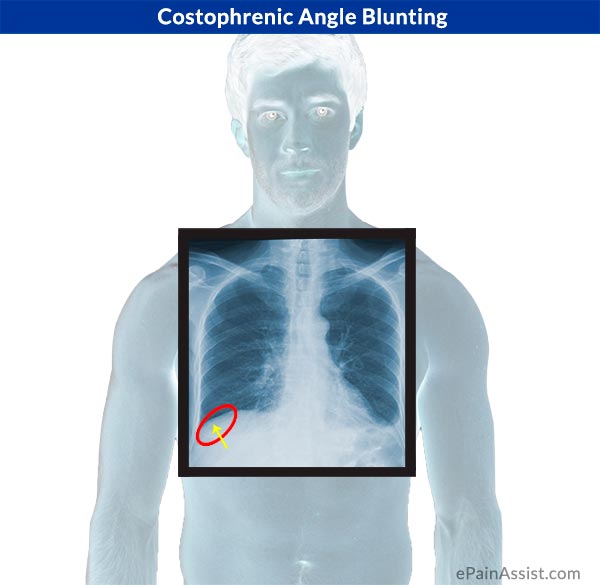Lung is one of the vital organs of our body. Lungs facilitate inhalation of oxygen and exhalation of carbon dioxide. Diseases and pathological changes of the lungs affect the breathing of an individual. There can be many reasons for a pathological condition to develop in the lungs. Breathing is affected when lungs are compressed from outside. The lungs are compressed from outside when air or water is trapped between lung and chest wall. Fluid around the lung causes a disease known as pleural effusion. Pleural effusion causes Costophrenic Angle Blunting. In this article, we will discuss about Costophrenic Angle Blunting in detail, the radiological changes, and how to correct the deformity.
What Is Normal Costophrenic Angle?
Costophrenic angle is located on posterior and lateral side of the lower chest wall where diaphragm meets lower rib cage. Costophrenic angle is observed on plain X-ray on right and left side. The angle is observed as a downward indentation between the left or right diaphragm and adjacent chest wall. Under normal circumstances, an extremely small part of each lung touches the costophrenic angle. Normal costophrenic angle measures approximately 30 degrees.
How Is Costophrenic Angle Blunting Defined?
Costophrenic angle blunting is a radiological finding or diagnosis. Word Costo is used to describe disease related to ribs and phrenic word is used to describe disease close to diaphragm. The acute angle between rib and diaphragm is considered normal when angle is less than 30 degrees and blunt when angle is more than 30 degrees. Angle becomes blunt in patients suffering with pleural effusion.
What Is Pleural Effusion?
Pleural effusion is a disease caused by collection of fluid in pleural space between visceral and parietal pleura. Visceral pleura are a thin membrane closely adheres to lungs and parietal pleura are closely adhering to chest wall.
What Causes Costophrenic Angle Blunting?
Costophrenic Angle Blunting Causes Include:
- Pleural Effusion- Collection of fluid outside lung between lung and chest wall. Costophrenic Angle Blunting is seen more often in individuals with Pleural Effusion. Pleural effusion is the accumulation of fluid in space surrounding the lungs, which can be due to some type of infection of the lungs.
- Pleural abscess- Abscess when localized within posterior and lateral plural space causes blunting of costophrenic angle on X-Ray.
- Hemothorax- Bleeding disorder or trauma may cause bleeding within pleural space and result in blunting of costophrenic angle
- Pulmonary Embolism- Pleural effusion is often caused by pulmonary embolism.1

Risk Factors Involved In Costophrenic Angle Blunting
- Diseases- Lung diseases like tuberculosis or pneumonia may cause pleural effusion.
- Trauma- Rib injury may cause hemorrhage in pleural cavity resulting in blunt costophrenic angle.
- Lung Cancer- Lung cancer may irritate pleural lining resulting in increased pleural secretion and collection of fluid in pleural cavity.
What Are The Symptoms of Costophrenic Angle Blunting?
Most common cause of blunt costophrenic angle is pleural effusion. Symptoms and signs are often similar to disease of pleural effusion.
Generally, small pleural effusions do not cause any significant symptoms. Larger sized pleural effusion when caused by significant fluid pleural cavity results in significant symptoms and signs.
Symptoms and Signs of Costophrenic Angle Blunting Are As Follows:
- Short of Breath or Dyspnea- Chest cavity lies within rib cage. Because of rib cage chest cavity has a fixed volume, which changes very little during breathing. Chest cavity encloses lungs, heart, trachea, bronchi and blood vessels. The accumulation of fluid around lung causes compression of lungs since volume cannot be expanded outward. Compression of lung causes symptom of short of breath or dyspnea.
- Chest Pain- Compression of lungs and expansion of pleura by fluid within pleural space causes chest pain
- Fever- Fever is observed when pleural effusion is infected.
- Cough- Irritation of visceral pleura triggers coughing.
Diagnosis of Costophrenic Angle Blunting
Chest X-Ray
- In order to confirm the diagnosis of Costophrenic Angle Blunting, the physician will order a chest x-ray.
- Individual experiencing symptoms suggestive of plural effusion is often advised to get X-Ray of Chest.
- X-Ray of patient suffering with Pleural Effusion, Hemothorax and Pleural Abscess more often will show Costophrenic Angle Blunting.
- The picture below shows how a Blunted Costophrenic Angle will appear on chest x-ray.

Computer Analysis of Digital chest X-Ray2
How is Costophrenic Angle Blunting Treated?
Treatment is divided as a conservative or specific treatment.
Conservative Treatment for Costophrenic Angle Blunting
a. Nasal Oxygen Treatment
- Symptoms of shortness of breath or dyspnea are treated with nasal oxygen.
b. Breathing Exercises
- Lung Expansion- Exercises are performed to expand partially collapsed lung because of pressure from fluid outside lungs.
- Exercise Breathing- The individual needs to be practicing this exercise on a daily basis for optimum results. To do this exercise, the individual needs to purse the lips together and breathe in for a couple of seconds and then breathe out keeping lips pursed. This needs to be continued for a couple of minutes. When the lips are pursed, it helps moisten the air before it reaches the lungs and thus the lungs are able to filter it more easily.
Elbow Breathing Technique for Costophrenic Angle Blunting
- This exercise is done to improve breathing.
- Exercise technique-
- Sit with the feet about shoulder width apart.
- Now, lift the elbows up to shoulder level.
- Then try and touch the fingertips together in front of chest.
- Inhale slowly while pulling the elbows and fingertips backwards.
- After pulling the elbow as far as possible, exhale and bring the arms back to the starting position.
d. Walking
- For people with partial collapsed lungs, walking is a bit of a challenge because walking may give rise to dyspnea.
- Walking is important to keep the muscles active and prevent weakness.
Specific Treatment for Costophrenic Angle Blunting
- Antibiotics for Costophrenic Angle Blunting
- Blood culture and culture of pleural fluid is performed before starting antibiotics. Antibiotics are selected according to bacterial sensitivity test.
- If the underlying infection, usually pleural effusion, is treated, then Costophrenic Angle Blunting resolves.
Some of the Treatments for Pleural Effusion Causing Costophrenic Angle Blunting Include:
- Intravenous Fluid
- Dehydration is treated with intravenous fluid or to give I. V. antibiotics.
- NSAIDs
- Prescribed for pain and
- Inflammation
- Thoracocentesis
- Needle is inserted in to pleural space and fluid is aspirated
- Aspirated fluid is sent for lab study
- Amount removed is calculated so as to replace fluid loss.
- Tube Thoracotomy
- Some time a tube is inserted in pleural space and left in for continuous drainage until antibiotic treatment is completed or cause of fluid collection is eliminated.
- Pleural Decortication
- Parietal pleura are surgically removed, procedure is known as decortication.
- Removal of pleura results in decreased secretions of serous fluid since pleura is removed.
- Pleurodesis
- Pleurodesis procedure is performed to obliterate the pleural space. The space between visceral pleura and parietal pleura is artificially obliterated. The surface of visceral and parietal pleura adheres to each other permanently when both the surface is irritated and inflamed.
- Pleural effusion in pulmonary embolism.
Semin Respir Crit Care Med. 2010 Dec;31(6):716-22.
Light RW. - Detection of pleural effusions on supine chest radiographs.
Ruskin JA, Gurney JW, Thorsen MK, Goodman LR.
AJR Am J Roentgenol. 1987 Apr;148(4):681-3. - Computerized delineation and analysis of costophrenic angles in digital chest radiographs.
Armato SG 3rd1, Giger ML, MacMahon H.
Acad Radiol. 1998 May;5(5):329-35.
